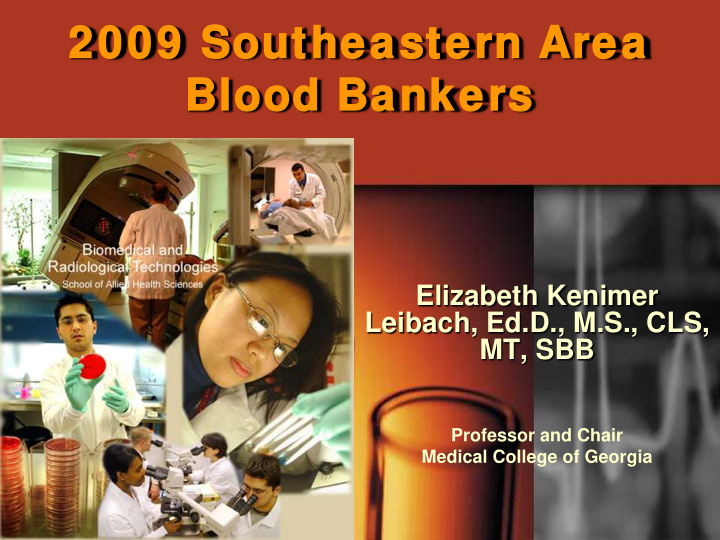



20 2009 09 So South utheas eastern tern Ar Area ea Bl Blood od Ba Bankers kers Elizabeth Kenimer Leibach, Ed.D., M.S., CLS, MT, SBB Professor and Chair Medical College of Georgia
SEABB March 4, 2009
Here re fro rom There re The Timeline… Greene County HS M.S. Cell and 42 years Molecular Biology 33 Years Doctor of Education 10 Years 1967 1972 1976 1981 1999 2010 PhD-CLS?? Specialist in Blood Banking B.S. Medical Technology SEABB 28 Years 39 Years March 4, 2009
Contribution of Blood Bank Education to Global Healthcare Mores SEABB March 4, 2009
Blood Banking Education in a Post- Modern World SEABB March 4, 2009
Growing the Blood Banking Workforce SEABB March 4, 2009
Integration of the “New Quality” Systems in Transfusion Services Delivery SEABB March 4, 2009
Contribution of Blood Bank Education to Global Healthcare Mores - OR - Emerging Role of Blood Banking in Quality Clinical Laboratory Services Delivery SEABB March 4, 2009
Prepare practitioners to refocus on appropriate use of health care services: – As much as 93% of objective data in the clinical record is contributed by the laboratory – An estimated 50-60% of all laboratory orders may be inappropriate – Most (68-87%) of laboratory errors are non-analytical – Clinical Laboratory Science Profession has claimed and accepted responsibility for the quality of the information provided by the clinical laboratory and for assuring its effective use in patient care. SEABB March 4, 2009
Raise the visibility of the laboratory and Profession through a direct patient care role: – Identify, describe, measure, provide for, and improve the ordering, dissemination, and utilization of medically effective and cost-efficient laboratory information – Provide the critical interface across the health care system to assure improved patient outcomes and cost effective patient care – The creation and integration of the DCLS completes the CLS “career ladder” with positions identified to address all areas of the laboratory industry including its leadership SEABB March 4, 2009
Blood Banking Education and Practice in a Post- Modern World - OR - The Blood Banking Practice Role Envisioned by the Clinical Laboratory Science Profession SEABB March 4, 2009
Establish a leadership role for CLS in the laboratory industry: – Work in the clinical laboratory is performed by non-physician scientists who report diagnostic information directly – Need for consultation in narrative interpretations of complex and diverse laboratory test options and results – Need for development and interpretation of practice guidelines and the collection and utilization of outcomes data – The DCLS will re-define existing relationships with other health care providers through consultation in a variety of new, non-traditional practice venues SEABB March 4, 2009
DCLS Practice • Clinical – Assess the effects of laboratory information on patient outcomes – Monitor effectiveness of clinical laboratory interventions • Translational (Evidence Based Practice) – Capture evidence – Write protocols – Monitor metrics – Communicate SEABB March 4, 2009
DCLS Practice Venues • Education for clinical practice • Applications: – Academe – Administration – Clinical / Safety and Quality – Government / Governance – Industry – Private Laboratory / Entrepreneur – Public Health SEABB March 4, 2009
Growing the Blood Banking Workforce - OR - Blood Banking at the Doctoral Level SEABB March 4, 2009
DCLS Requires BS-CLS Foundation Biomedical Science Patient Interactions CLS Diagnostics Research Services Delivery Clinical Chemistry, Hematology, Immunohematology, Microbiology, Immunology/Serology, Coagulation, Molecular, Emerging Diagnostics, Test System Evaluation, Algorithm Interpretation, Decision-Making, QA/QI, Education, Communications, Management, Finance, Information Management, Research, Ethics BS-CLS Foundation SEABB March 4, 2009
The CLS Career Ladder PhD / DCLS Post-Prof MS MS BS CLS / MT CLS / MT BS Non- CLS / MT CLS / MT SEABB March 4, 2009
Integration of the “New Quality” Systems in Transfusion Services Delivery - OR - How We Get There from Here SEABB March 4, 2009
DCLS ad hoc Committee 2009 Focus “When gold argues the cause, eloquence is important.” Publilius Syrus, “Moral Sayings” (first century BC) SEABB March 4, 2009
• The CLS Scope of Knowledge is defined, standardized, protected, and transferred through formal education programs • Need partnerships among academic institutions, clinical providers, and industry to create formal programs and hire graduates • Involvement in our professional organizations is critical SEABB March 4, 2009
To Partner in Clinical Laboratory Leadership “Whoever controls guidelines controls medicine.” Eddy, D (1990). Clinical decision making: from theory to practice. Practice policies: what are they? JAMA 263: 877-880. SEABB March 4, 2009
Recommend
More recommend